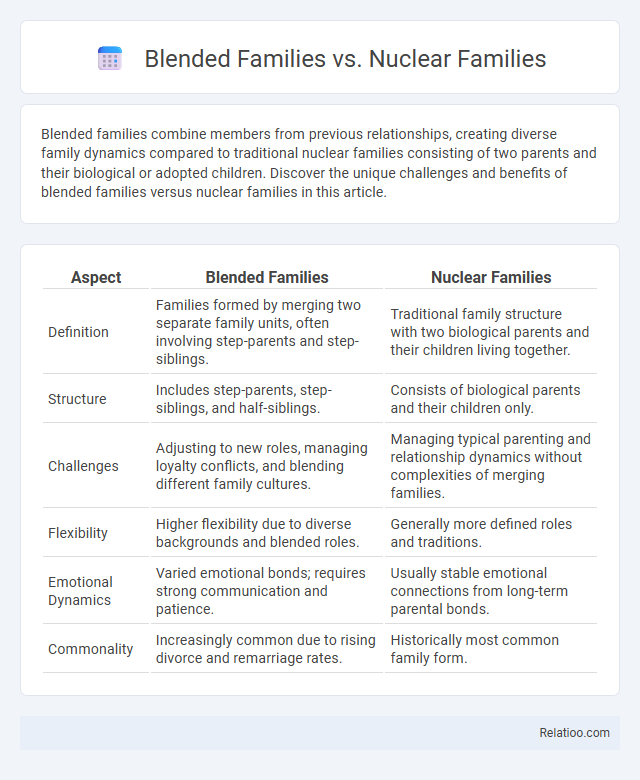Blended families combine members from previous relationships, creating diverse family dynamics compared to traditional nuclear families consisting of two parents and their biological or adopted children. Discover the unique challenges and benefits of blended families versus nuclear families in this article.
Table of Comparison
| Aspect | Blended Families | Nuclear Families |
|---|---|---|
| Definition | Families formed by merging two separate family units, often involving step-parents and step-siblings. | Traditional family structure with two biological parents and their children living together. |
| Structure | Includes step-parents, step-siblings, and half-siblings. | Consists of biological parents and their children only. |
| Challenges | Adjusting to new roles, managing loyalty conflicts, and blending different family cultures. | Managing typical parenting and relationship dynamics without complexities of merging families. |
| Flexibility | Higher flexibility due to diverse backgrounds and blended roles. | Generally more defined roles and traditions. |
| Emotional Dynamics | Varied emotional bonds; requires strong communication and patience. | Usually stable emotional connections from long-term parental bonds. |
| Commonality | Increasingly common due to rising divorce and remarriage rates. | Historically most common family form. |
Understanding Blended Families
Blended families consist of partners and their children from previous relationships, creating a unique family dynamic different from traditional nuclear families, which include two parents and their biological children. Understanding blended families involves recognizing the complexities of merging different family cultures, managing co-parenting arrangements, and addressing emotional challenges, which can often be influenced by social stigma. Your awareness of these factors helps foster empathy and support for blended families navigating societal judgments and internal adjustments.
Defining Nuclear Families
A nuclear family consists of two parents and their biological or adopted children living together as a single unit. This family structure is often viewed as the societal norm, influencing cultural expectations and social policies. Understanding your family's dynamic within this framework helps navigate potential social stigmas faced by blended families.
Key Differences Between Blended and Nuclear Families
Blended families consist of members from previous relationships combined into one household, whereas nuclear families typically include two parents and their biological children living together. You may experience unique social stigma challenges in blended families due to societal expectations favoring traditional nuclear structures. Key differences include family roles, dynamics, and legal complexities that are more common in blended families compared to the relatively straightforward framework of nuclear families.
Benefits of Blended Family Structures
Blended families offer unique benefits such as increased emotional support and resource sharing among diverse family members, fostering resilience and adaptability. Research shows children in blended families often develop enhanced social skills and flexibility due to navigating complex relationships. Unlike nuclear families, blended families can provide enriched cultural perspectives and a broader sense of community, helping to reduce social stigma through inclusive family dynamics.
Advantages of the Nuclear Family Model
The nuclear family model offers advantages such as increased stability, clearer parental roles, and stronger emotional bonds between parents and children, which contribute to a supportive and consistent environment. Research indicates children in nuclear families often experience fewer behavioral problems and higher academic achievement due to focused parental attention and resources. Unlike blended families, nuclear families face less social stigma, promoting a sense of normalcy and acceptance within traditional societal frameworks.
Common Challenges in Blended Households
Blended families often face common challenges such as navigating complex relationships between stepparents and stepchildren, managing differing parenting styles, and addressing loyalty conflicts that can create tension within the household. Your ability to foster open communication and establish clear boundaries plays a crucial role in overcoming social stigma linked to non-traditional family structures. Unlike nuclear families, blended households must work harder to build trust and cohesion while confronting external judgments and stereotypes.
Communication Dynamics in Both Family Types
Communication dynamics in blended families often involve navigating complex relationships among step-siblings and stepparents, requiring increased emotional intelligence and conflict resolution skills. Nuclear families typically experience more straightforward communication patterns due to established roles and fewer relational disruptions, fostering consistent dialogue. Your ability to foster open, empathetic communication can reduce social stigma by promoting understanding and cohesion across both family types.
Parenting Roles: Blended vs. Nuclear Families
Parenting roles in blended families often require greater flexibility and cooperation as step-parents navigate complex relationships with stepchildren and ex-partners, while nuclear families typically have more clearly defined parental responsibilities shared between biological parents. You may face unique challenges in blended families, such as establishing authority and fostering unity, which contrasts with the more traditional, predictable dynamics of nuclear family parenting. Social stigma can amplify pressures on blended families to conform to conventional parenting roles, making open communication and role negotiation critical for healthy family functioning.
Emotional Well-Being of Children in Different Family Setups
Children in blended families often face unique emotional challenges such as loyalty conflicts and adjustment stress, impacting their overall well-being differently than those in nuclear families, where stability and consistency typically foster stronger emotional security. Social stigma surrounding blended families can exacerbate feelings of exclusion and anxiety in children, while nuclear family structures generally experience fewer prejudices, promoting healthier emotional development. Understanding these dynamics is crucial for providing targeted emotional support that enhances resilience and well-being in children across diverse family setups.
Choosing the Best Family Structure for Modern Life
Blended families, composed of partners and stepchildren from previous relationships, offer flexibility and resilience compared to traditional nuclear families, which consist of two parents and their biological children. Social stigma surrounding blended families often stems from misconceptions, but modern life demands adaptive family structures that prioritize emotional support and practical collaboration over conventional norms. Choosing the best family structure involves evaluating individual needs, communication dynamics, and societal acceptance to foster healthy relationships and well-being.

Infographic: Blended Families vs Nuclear Families
 relatioo.com
relatioo.com